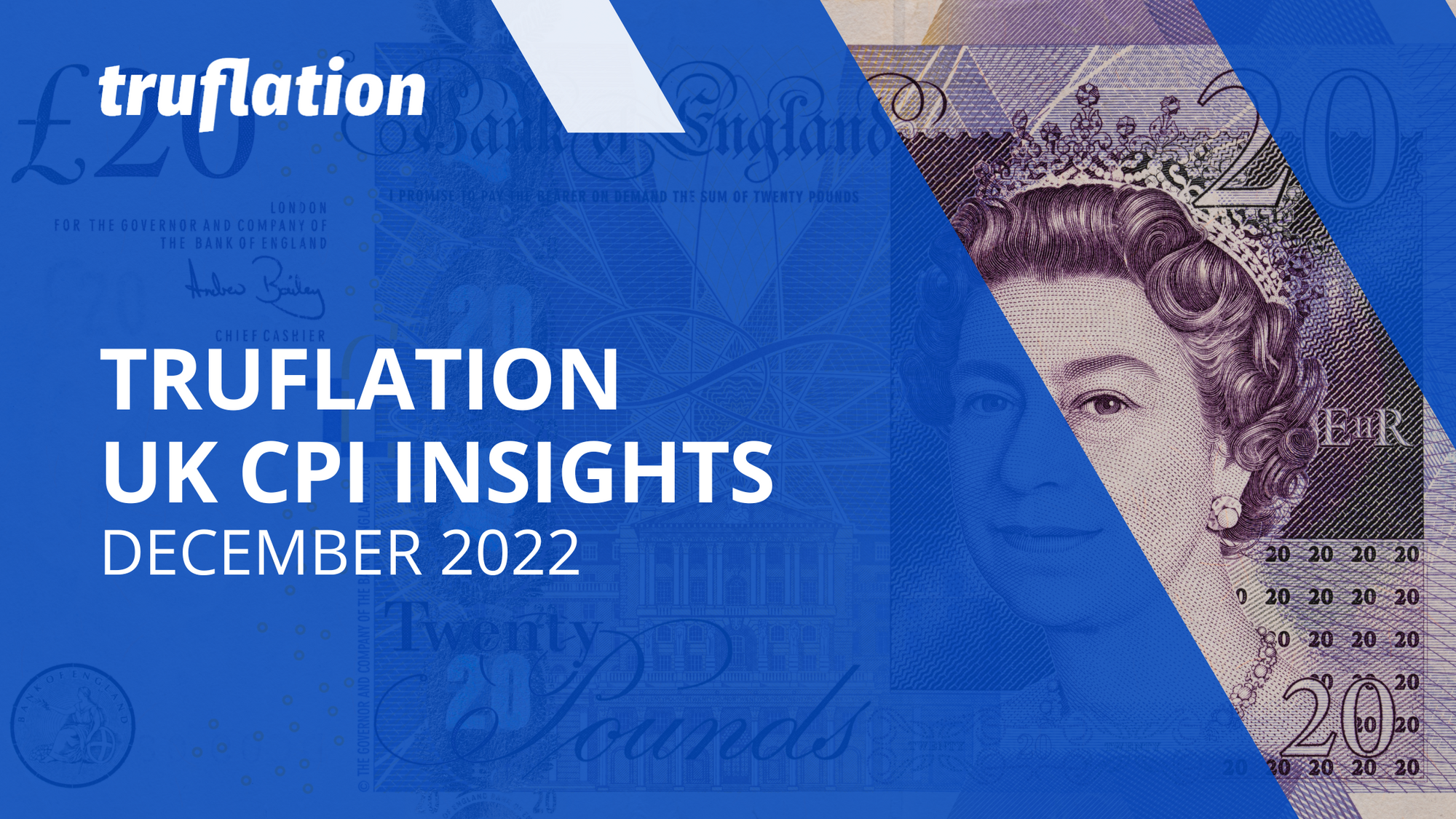
Truflation UK Data Insights: December 2022
Published 13 Dec, 2022
The FTSE 100 index of the largest companies in the UK recorded its best month in two years in November, jumping 6.7% over the 30-day period, while the Pound Sterling continued to strengthen against the US dollar.
Source: Yahoo Finance
A rising Pound is usually accompanied by a dip in the FTSE 100 due to the global nature of companies that make up the index. Yet in November, this was offset by rising commodity, energy and consumer staples stocks. These same sectors were among the biggest contributors to the soaring inflation rates, as the cost of living crisis in the UK shows no signs of abating.
The reported inflation rate in the UK continued to rise in October, with CPI hitting a 41-year high of 11.1% driven by rising food and energy prices. This marks a full percentage point increase from the previous month. Meanwhile, the CPIH, which includes additional homeownership costs, reached 9.6%, up from 8.8% the month before.
Source: Office for National Statistics
On Wednesday, 14 November, the UK Office for National Statistics (ONS) will announce the latest monthly UK CPI figures. Let’s delve into the outlook for UK inflation based on Truflation data.
In October 2022, we saw the Truflation UK index rise to an all-time high of 17% (as of Oct 22), before dropping slightly to 16.8% by the end of the month. In November, the index continued to rise, hitting a new high of 18.5% by the end of the month.
Source: Truflation, as of Dec 7, 2022
This increase has primarily been driven by three main categories: utilities, housing prices and food prices. Below, we break down the contributions of these three sectors to UK CPI figures.
- Utilities: While the Truflation Utilities index dropped from a peak of 87.4% in October to 81.3% by December 7, prices remain extremely elevated compared to the same time last year. This is primarily driven by Electricity and Natural Gas costs, which have nearly doubled compared to December 2021. While the energy price cap introduced by former PM Liz Truss is helping to keep prices in check, the higher usage of utilities by British households as winter sets in can be expected to keep expenditure elevated.
- The Housing category (including owned dwellings, rented dwellings, and other lodgings) is up more than 40% year-on-year and 10.97% since last month. This increase can be attributed to the rising interest rates, after the Bank of England voted to raise rates by 0.75% to 3% in its November meeting. Other culprits are rising rent costs and, to a lesser extent, higher housing prices, with the average price of a home in the UK up 7.8% year-on-year in October. However, with further rate hikes expected in the near term, we are likely to witness a reversal of the relentless upward trajectory in UK house prices, which have been climbing continuously for nearly a decade.
- The Food category also continued to contribute significantly to UK inflation, despite an overall drop versus the previous month. Compared to the same time last year, this category is up 6.6%. In particular, we have witnessed a 14.5% increase in fresh food prices year-on-year, as well as an 11.9% rise in frozen food costs, and a 10.3% increase in the price of beverages compared to the same time last year. Meanwhile, the rising costs of energy, animal feed and transportation have contributed to price hikes for meat, eggs and dairy.
Amid significant production concerns, especially with the onset of winter negatively affecting local production, food prices can be expected to remain elevated in the coming months. The National Farmers' Union (NFU) has recently warned that the UK could be “sleepwalking” into a food supply crisis, with the country already experiencing egg shortages, pointing to energy-intensive crops such as tomatoes, cucumbers and pear as the potential next casualty.
Against the backdrop of rising costs of food and fuel, many British households are facing a bleak winter. According to the ONS, two in five British households have already been forced to cut back on food shopping and essentials in the first half of November.
Meanwhile, although the Bank of England is expected to slow down its pace of interest rate hikes to 0.5% in December, these remain on an upward trajectory. All of this means Christmas celebrations are likely to be subdued, while households will keep their purse strings tight throughout the rest of the year and going into Q1 2023. We can expect to see the prices of gas stabilising as the winter months draw to a close, yet upward pressure on the CPI index can be expected to linger for months to come.
“We expect CPIH to come in at around 10.7% tomorrow based on the preliminary forecast models using Truflation data. We prefer CPIH to CPI as a measure of inflation as we believe it doesn’t make sense to exclude Housing, which is an intrinsic part of household expenditure and therefore a key component of household inflation,” said Oliver Rust, Truflation's Project Lead and Data Expert.
The Truflation forecasting model predicts that the CPIH, currently at 9.6%, will go up to 10.7%.
These predictions are based on our proprietary model that aggregates prices from more than 8 million items using data from 15 data partners and is updated daily. The Truflation index is similar to the CPIH in that it includes costs of owning a home, maintenance and services costs, as well as mortgages and mortgage rates. In that, our index might be running a tad higher due to the BoE tightening policy.
About Truflation
Truflation is an economic data aggregator serving independent, unbiased, real-time data. Truflation’s mission is to help individuals, investors, companies, and institutions make more informed decisions by accessing independent and unbiased economic information.
Get Exclusive Insights
with our Weekly Newsletter